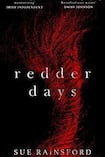
Reading dystopian fiction during a pandemic feels a bit masochistic. I admit my heart sank a little at the prospect of Redder Days, which is set in a world wracked by climate change and a mysterious contagion. It is huge testament, therefore, to the talents of the young Irish author Sue Rainsford that I was drawn in and completely gripped by this dark, mysterious tale.
Rainsford is a unique new voice in Irish writing. She stands apart from her millennial peers – her novels are a million miles away from You Know Who – and that is precisely what makes her so interesting.
Redder Days is Rainsford’s second novel, following her much-praised 2018 debut, Follow Me to Ground, for which she received the Kate O’Brien Award. That book tells the story of a non-human young woman who can heal people by reaching inside them and taking away their illness.
We are on similarly strange terrain here. Redder Days opens somewhere in the recognisable future on a kind of survivalist commune. The action takes place after a climate disaster has caused mutations in animals and humans, and sparked a contagion, referred to only as Red.
At the heart of the novel are the twins Anna and Adam, who were born on the commune. Their mother, Eula, came to the commune when she was pregnant with them in search of a place to wait out the imminent end of the world. She has long since abandoned the twins but they are still waiting, keeping watch for the apocalypse and the odd refugee who stumbles into their camp. If they show any symptoms of Red, Anna takes care of them with the shotgun her mother left behind.
The story is broken into four parts, and is told by several characters, switching between past and present. Anna and Adam are the main voices. Then there is Koan, the one-time leader of this group of survivalists who has retreated to his cabin and is losing his grip on reality. We hear his side of the story through the volumes of journals he obsessively writes. Two other characters, Tabatha and Matthew, inform us about the reality outside the commune, which is one of the saddest and most affecting aspects of the story.
When we finally get to hear Eula’s voice in the last pages of the book, I found myself wishing Rainsford had used her more throughout the novel, instead of the limp Tabatha. For the most part, however, the characters are brilliantly drawn and so strong it feels more accurate to describe them as channelled rather than written.
Fairytale
Rainsford’s writing style is closely worked, the language so sinewy and tightly strung that it quivers. She’s a sensual writer too – to read her work is to feel the heat of the sun on your back, to smell the blood she describes on the wooden floor, and the dirt of the commune under your fingernails.
There are elements of the fairytale to this novel – the mysterious forest, the power of the natural world, the symbolism of twins – and Rainsford uses all of these elements to explore themes of gender, power balance, religion, family and community, and to highlight the dangers of insularity, ignorance, fear and blind faith.
Unsurprisingly, the book functions as a melancholic parallel to the world we live in now, in the grip of a pandemic and on the precipice of climate disaster. Line after line resonates. Take the following: “We weren’t meant to be here this long. There shouldn’t have been all this time, too much time, and inside of it everything turning sour.” It’s impossible not to think of our protracted lockdowns.
But what does it all mean? By the end of Redder Days I had many unanswered questions, and I was still pondering it for days afterwards. The experience of reading this book reminded me of the experience of viewing an opaque art exhibition – you walk around the gallery, some things strike you deeply, and some things you’re not even sure you have understood. Rainsford regularly collaborates with artists and has a qualification in visual art, so it makes sense that there is an abstract, inscrutable aspect to her writing.
Still, on the whole, the book worked for me. As a sort of fable, Redder Days examines the best and worst of our human instincts, and evokes our darkest fears. It asks the philosophical question: what does it mean to be human in a world gripped by fear and change, and how do these forces work on our humanity?
A pertinent, prescient question for our times . . . if you can bear to address it.

















